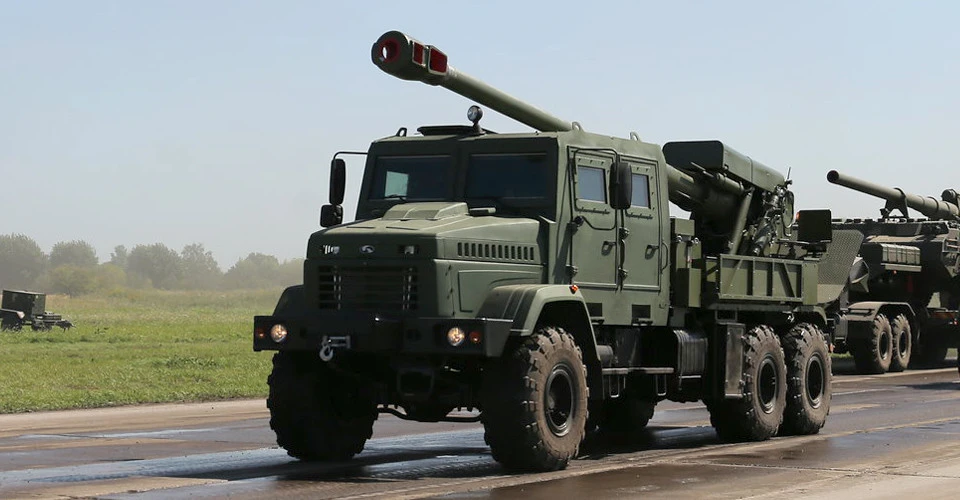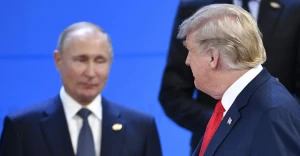
War and money: Ukraine's economy in the third year of Russia's full-scale invasion
How Ukraine managed to ensure the functioning of the economy and banking system in the context of full-scale war, what it could have faced without international financial aid, and whether the defense industry can ensure GDP growth
Contents
1. How Ukraine managed to maintain financial stability in wartime
2. Could Ukraine manage without international financial aid?
3. From historic GDP decline to gradual recovery in 2024
4. Can the military-industrial complex drive the economy?
5. The war's greatest challenge – loss of lives
The first air raid sirens that rang out across the country on the morning of February 24, 2022, were a shock even for those who were certain that Russia would invade Ukraine and had already packed an emergency bag. In the first days of the war, people rushed to withdraw cash from ATMs, bought up food, filled their car tanks, and mass-evacuated from cities. Despite everything, except for the areas that suddenly became combat zones, life continued on the rest of the country's territory: food was delivered to stores (although there were shortages of some products), it was still possible to pay with cards, and trains were running more or less on schedule. Predictions of the dollar reaching 100 UAH and food rationing did not come true. Read more about how the Ukrainian economy has changed over the past three years, what has become the biggest challenges, and what has become a support, in the Espreso article.
How Ukraine managed to maintain financial stability in wartime
As of February 24, 2022, the official exchange rate of the dollar in Ukraine was 29.25 UAH, and the euro was 33.17 UAH. Currently, the dollar exchange rate is 41.73 UAH, and the euro is 43.0 UAH. This means the hryvnia has weakened, but apocalyptic predictions of the dollar reaching 50 or even 100 UAH have not come true after three years of major war. There was also no mass bankruptcy of banks. As of January 1, 2022, there were 71 commercial banks in Ukraine, and as of January 1, 2025, there are 61.
Moreover, the day after the full-scale invasion, the National Bank withdrew banking licenses and liquidated banks under Russia's control: the International Reserve Bank, which belonged to Sberbank of Russia, and Prominvestbank, which belonged to the Russian state corporation VEB.RF.
"We can identify at least 3 stages in the financial policy of the country during the great war," says Vasyl Furman, a member of the National Bank of Ukraine (NBU) board, in a comment to Espreso. "The first stage was the initial shock of the Russian invasion. The actions of the NBU at this stage: fixing the exchange rate, abandoning the inflation targeting regime (including changes in the discount rate and the forecasting process); strict administrative restrictions on capital outflows, maximum support for conducting payments (allowing banks to use cloud services abroad) and access for citizens to payments (continuous operation, the ability to withdraw cash from terminals in retail networks, etc.), regulatory easing for banks (postponing stress testing and new capital requirements for banks)."

A line at the ATM on February 24, 2022, in Horodok, Lviv region
Moreover, according to Vasyl Furman, in 2022, the National Bank of Ukraine conducted large-scale monetization of the budget deficit – 400 billion UAH, in the absence of external financing during the first months of the invasion.
"The second stage – the gradual adaptation of economic agents and preventing the accumulation of imbalances. By the summer of 2022, it became clear that further fixing of the exchange rate would lead to the rapid depletion of reserves amid the adaptation (and the search for ways to bypass) of economic agents to the imposed restrictions," says Vasyl Furman. "The actions of the National Bank – 're-fixing' the exchange rate at a new fixed rate (36.6 UAH per dollar), returning to elements of inflation targeting – a sharp increase in the rate to 25%, including to maintain the attractiveness of savings."
At that time, the National Bank of Ukraine lifted some restrictions, gradually reduced, and eventually abandoned monetary financing of the deficit as external financing inflows increased.
"2023-2024 are the third stage of financial policy – a gradual 'normalization' of policy (as much as this term can be acceptable in the context of the ongoing war)," says Vasyl Furman. "The National Bank Council approved new Medium-Term Monetary Policy Guidelines, granting the management more flexibility in achieving the goal (in particular, the policy horizon was effectively extended from 18 months to 36 months). Economic agents must understand that the exchange rate can fluctuate in both directions, and there must be a gradual return to market mechanisms for managing currency risks, rather than relying on pegging. Gradual currency liberalization, flexible inflation targeting, and the return to stress-testing are among the measures."
Could Ukraine manage without international financial aid?
"I'll be honest with you and won't reveal any great secret – we are critically dependent on external assistance," says Vasyl Furman. "For the third consecutive year (2022-2024), the state budget deficit stands at about 25% of GDP. The scale of this phenomenon can be understood if we recall that a 'normal' budget deficit is considered to be within 4% (preferably 2%), and such a situation should not be permanent. It's clear that Ukraine does not have this amount of resources. In fact, expenses have doubled, and the government cannot double taxes and levies. Even under normal economic conditions, it doesn’t work that way, and even more so in wartime."
According to the member of the National Bank of Ukraine's board, the volume of financing from international partners in 2022-2025 (as of the end of January 2025) amounted to $118.3 billion. This is compared to Ukraine's entire pre-war nominal GDP, which was around $200 billion.
"In case of a significant reduction in external assistance, Ukraine will face a 'simple' choice: to cease resistance or to seek internal sources of funding," says Vasyl Furman. "The second path will be painful and will essentially require financial repression against citizens and businesses: their incomes will have to be forcibly redirected to defense needs."
How might this look? One can refer to examples from the United States (where business tax rates reached up to 90%, citizens could only spend on a specific list of products, and "voluntary-compulsory war bonds") and Great Britain (ration cards and restrictions even on basic needs). Clearly, such a scenario is undesirable, but Ukraine must already demonstrate to its partners ways and mechanisms for increasing "self-sufficiency," transparency, and accountability. This will help reduce arguments about the "misuse" of funds by Ukraine.
Investment banker Serhiy Fursa also confirms that Ukraine is critically dependent on external support. However, despite the alarming news of recent weeks, there is no need to worry about a significant reduction in financial assistance in the near future.
"Half of our budget has been financial aid from our Western partners for the fourth year in a row. If we’re talking about financial assistance, it’s critically important. It helps a bit that we’re a poor country and it’s much cheaper to pay Ukrainian pensioners than German ones," says Serhiy Fursa. "At the same time, there are no grounds for this financial aid to decrease. We are guaranteed financial assistance for the entire 2025 year, with decisions already made, partially for 2026 as well. So, there are no grounds to talk about a reduction in financial assistance."
Currently, it is expected that in 2025, Ukraine will receive over $38 billion, and approximately $25 billion in 2026.
From historic GDP decline to gradual recovery in 2024
In 2022, Ukraine's real GDP shrank by 29.1%. This was the largest decline in Ukraine's history, and it was entirely logical: Russia occupied part of the territory, and many logistics chains were disrupted. Due to the lack of air traffic and the blockade of ports, Ukrainian businesses were unable not only to export goods but also to receive raw materials and components for production.
In 2021, Ukraine showed record export growth - up 38.4% compared to 2020 (to $68 billion). Imports increased by 34% to $72 billion. According to the State Customs Service, in 2022, goods worth $55.5 billion were imported into Ukraine, and $44.2 billion worth of products were exported from Ukraine. The most challenging year for Ukrainian exports was 2023, when, in addition to problems with maritime logistics, EU farmers blocked borders. That year, exports reached only $36 billion, while imports amounted to $63.5 billion. However, by 2024, exports had increased to $41.6 billion, and imports grew to $70.7 billion.
"I wouldn't say that the Ukrainian economy has transformed in any way over the three years of full-scale war. Of course, the war impacts the economy, with the sectors that were hit hardest shrinking the most," says investment banker Serhiy Fursa. "For example, there were three sectors that demonstrated the highest export earnings: metallurgy, agriculture, and IT. The dynamics in IT have changed. We're talking about a certain decline, not catastrophic, but a decline compared to the constant growth of previous wealthy countries. But this is caused not only by the war but also by global dynamics. The agricultural sector has almost maintained its position, especially when exports were restored via ports. As for metallurgy, it was a mechanical loss, related to difficulties with electricity, labor force issues."
Overall, despite the unfavorable situation at the front, massive attacks on critical infrastructure, and hourly power outages, the Ukrainian economy still demonstrated growth last year.
According to the National Bank of Ukraine's estimates, in 2024, Ukraine's real GDP grew by 3.4%. "This result was achieved thanks to the resilience of the Armed Forces of Ukraine, the endurance of businesses and the population, the preservation of significant international support, and state measures for infrastructure recovery and social protection," states the NBU's inflation report for January 2025. "The main factors still holding back the economy are the consequences of the war: destruction of critical infrastructure, industrial production, as well as a lack of workers in enterprises due to migration and mobilization processes. Despite these challenges, the NBU expects that in 2025-2027, the economy will grow by about 4% annually. Further recovery will be supported by the expected increase in harvests and growth in investments for Ukraine's reconstruction, including from private businesses and foreign investors."
In Ukraine, business lending has been growing for a year and a half. Despite some seasonal slowdown in the fourth quarter of 2024, the annual increase was 20.6%. Meanwhile, net hryvnia loans to the population grew by 39.9% over the year. This indicates a revival of the economy, as much as possible under the conditions of a full-scale war.
Consumer prices increased by 12%. The National Bank of Ukraine expects inflation to decrease to 8.4% in 2025 and to the target of 5% by 2026.
Can the military-industrial complex drive the economy?
In 2025, 26.3% of the country's GDP will be allocated to security and defense. Overall, expenditures will rise to 2.23 trillion UAH. In comparison, in 2022, only 323.1 billion UAH, or 6% of GDP, was initially planned for security and defense. However, due to the full-scale invasion, the budget had to be revised, and as a result, security and defense expenditures increased by 1.23 trillion UAH, reaching 1.485 trillion UAH, or 32.5% of GDP. In practice, all taxes and fees collected in the budget are currently allocated to security and defense, while social spending is financed through international financial assistance.
Despite what seems like significant defense spending, these funds are not enough to ensure the combat readiness of the Ukrainian military.
"The defense funding from Ukraine's budget, I’m not sure if it even covers half of the needs. A lot is provided by our partners - not just the USA, but also many countries from Europe. And it’s not always money, it’s also technology," says military expert Viktor Yahun. "For example, there was information back in December and January that the USA, without making it public, invested around $1.5 billion in our drones. And we moved forward - we experienced a 'breakthrough' in drone development."
At the same time, he is confident that the military-industrial complex can be a driver of the economy.
"We see this in the example of Israel, where being in a permanent state of war has allowed not only military enterprises to thrive but also various startups, which primarily focus on serving the army, and only then on civilian needs. Therefore, the defense industry is a serious driver of the economy, especially since instability in Europe will persist as long as Putin's regime exists," says Viktor Yahun. "We need to boost the economy through arms production, which is why we are attracting the latest investments there. For instance, Rheinmetall wants to open three factories."
At the same time, the expert is confident that over the past three years, while Ukraine’s economy has not fully shifted to military production, it has nonetheless made significant progress in this direction.
"Clearly, many things we had to move to our closest partners because it’s a matter of security. We can’t fully protect certain productions from the aggressor. Russia can target them even in Uzhhorod. So, in reality, everything that could be done under these conditions was done," says Viktor Yahun. "There are local productions in the western region, new ones are being created. There are startups, grant programs. But who is supposed to fund this?"
At the same time, Viktor Yahun believes that investment in the defense industry should come not only from the state but also from private capital.
"Private capital needs to be given more opportunities for development, and it can definitely handle 60-70% of the load because it’s more flexible than the state. This has always been the case everywhere.
Therefore, the state should probably provide more opportunities, not just for production but also for selling to the West. This is one of the flaws that wasn’t accepted – that if something is produced and produced in quantities greater than needed for the Ukrainian Armed Forces, it can be exported to generate revenue and develop the enterprise, allowing our armed forces to receive the best, both in quality and quantity."

According to the expert, Ukraine's defense industry has made significant achievements over the three years of war.
"First of all, there are the marine drones and long-range drones. There is also active development in missile production. As for heavy weapons, we can clearly show the Bohdana self-propelled howitzer. Its production has developed incredibly and has reached very strong quantitative and qualitative indicators. So, in fact, we have achievements, and quite significant ones, in the defense industry," says Viktor Yahun.
The private company Ukrainian Armored Vehicles, which, among other things, supplies chassis for the Bohdana self-propelled howitzer and is a contractor for the Luch design bureau, has increased its revenue by 470 times since the full-scale invasion. The company's CEO, Vladyslav Belbas, stated in an interview with Forbes Ukraine that by the end of 2024, revenue could increase by half compared to 2023, exceeding 48 billion UAH. For comparison, in 2021, the company's revenue, which is the largest private arms manufacturer, was 103 million UAH.
At the same time, Serhiy Fursa believes that the military-industrial complex can make a significant contribution to economic growth but should not be expected to become the main driver of economic growth.
"Despite the significant increase in production, we cannot talk about a substantial acceleration of GDP because this sector is heavily dependent on imports. We assemble from imported components, so it doesn't strongly impact GDP, for example," says Serhiy Fursa. "Europe already has a rather limited potential for increasing arms production, and it's clear that this increase is expected. Here, Ukraine could become a large weapons manufacturing hub, but only after the war ends. It will be a significant contribution to the economy. However, we still understand that modern economies primarily rely on added value, which is created in services, in information technology, where people are involved. In other words, people bring the main added value."
The war's greatest challenge – loss of lives
According to data from the State Statistics Service, Ukraine had a population of 41 million at the beginning of February. However, the State Statistics Service has not published any further data on the population since then. Estimates suggest that between 4 and 6.5 million people left Ukraine during the full-scale invasion. Overall, the population of Ukraine-controlled territory in 2025 is expected to be 33 million, according to an IMF forecast. This presents a much more serious challenge for the economy than the losses in Ukraine's energy sector, which the IMF estimated at $56.5 billion in its July 2024 report.
Currently, businesses are facing a labor shortage. In employment centers, there are two to three job vacancies for each job seeker. Businesses are competing for skilled workers and, even with limited budgets, are trying to find resources to raise salaries. The shortage of personnel is especially acute for relocated industrial enterprises, which require highly specialized professionals. Meanwhile, in western Ukraine, where there are not many large industrial enterprises, such specialists are also in short supply.
"Yes, by the end of last year, real wages in enterprises across various sectors were generally higher than before the full-scale invasion. The wage growth rates are outpacing inflation, meaning they are more than compensating for the increase in prices for goods and services. The NBU expects that in 2025–2027, real wages will also continue to grow by 3-4% per year," the National Bank forecasts.
"Depopulation will be the biggest challenge for Ukraine's economy for at least the next 20-30-40 years," says Serhiy Fursa. "Businesses are already feeling the workforce issues. We need to prepare for a labor crisis and migration. It's important that the process of labor migration to Ukraine be controlled and led by the state, rather than being chaotic. We shouldn't be afraid of migrants, we should pray for them. Because if they don't come to Ukraine, we won't have enough to pay pensions. We are doomed to labor migration — otherwise, we won't have a normal economy."
- News











































